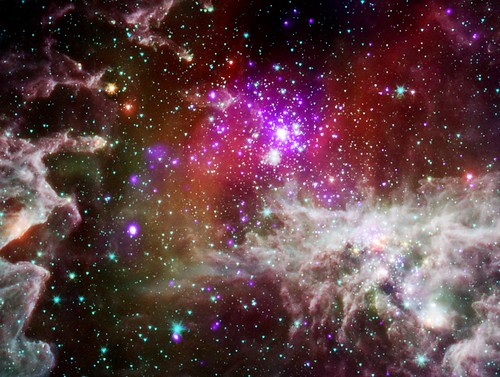Awesomeness Round-Up – 10/3/2011
- By Maggie Masetti
- October 3, 2011
- 1 Comment
There are gorgeous new shots of a full-scale test version of one layer of the James Webb Space Telescope’s tennis court-sized sunshield:
There are two more on their Flickr.
A new outdoor laser exhibit at the Maryland Science Center presents a unique blend of astronomy and art. Hubble spectral observations of distant galaxies are projected onto the Maryland Science Center with an intense green laser. Educational activities will allow students to explore the world of light and color in astronomy.
The Hubble Space Telescope is famous for its spectacular images of distant galaxies, glittering stars, and colorful planets. But Hubble does more than just take pretty pictures. Its suite of instruments can also divide light into a rainbow of color called a spectrum. Encoded in the spectrum is a host of information about celestial objects, including their motion, chemical composition, and temperature. Spectroscopy is crucial for finding black holes, characterizing the atmospheres of other planets, and plumbing the depths of the invisible universe.
Normally, only astronomers see these invaluable spectral signatures. But German artist Tim Otto Roth and the Space Telescope Science Institute in Baltimore have teamed up to transform the Hubble data into vibrant waves of emerald green light from a high-powered laser which ripple across the steel facade of the Maryland Science Center. This laser projection looks like a string of squiggly lines. It takes an astronomer’s trained eye to decode a star’s signature into new information sent to us from billions of years ago by galaxies, stars, and quasars.
These photos show the Hubble Advanced Camera for Surveys grism spectra being projected.
A number of educational activities are built around the theme “Exploring the World of Light and Color,” that will be done in cooperation with the Maryland Science Center.
The exhibit runs through October 18. Hours are from 7 p.m. to 11 p.m. each evening. The Maryland Science Center is located at 601 Light Street in Baltimore.

Credit: NASA, ESA, G. Kriss (STScI), and J. de Plaa (SRON Netherlands Institute for Space Research);
Acknowledgment: B. Peterson (Ohio State University)
Black holes remain some of the most mysterious objects in the universe, especially the ones with really outrageous behavior. Meet active galaxy Markarian 509, nearly 500 million light-years from Earth. The central black hole in this galaxy is 300 million times the mass of the Sun, and getting bigger every day. The turbulent swirling matter entering the black hole makes its emissions vary in brightness, which makes it a popular observing target for satellites. In an attempt to better understand how Markarian 509 works, scientists pooled multiwavelength data from several different spacecraft – Hubble (ultraviolet – COS instrument), Chandra (X-ray), XMM-Newton (X-ray), Swift (gamma-ray), and INTEGRAL (gamma-ray) – for a greater level of detail and understanding, especially in the behavior of gas surrounding it.

Credit: X-ray: NASA/CXC/CfA/S.Wolk; IR: NASA/JPL/CfA/S.Wolk
This image of stellar cluster NGC 281 combines X-ray data from Chandra (purple) with infrared observations from Spitzer (red, green, and blue). This cluster, known informally as the Pacman Nebula, gives astronomers an unusually clear view of the star-forming region within. Awww, it’s a baby star nursery!
It’s apparently NASA Tweetup season, with new opportunities being posted every few days! This week, registration opens for a tweetup at Kennedy Space Center for the launch of the Mars Science Laboratory Curiosity rover at the end of November. Visit the NASA Tweetup site for more details, including information about the event and registration later this week.







Some of the pictures being captured today with the latest technology are almost beyond imagination. The brightness, the colors, the sheer majesty of it all. It just thrills me.